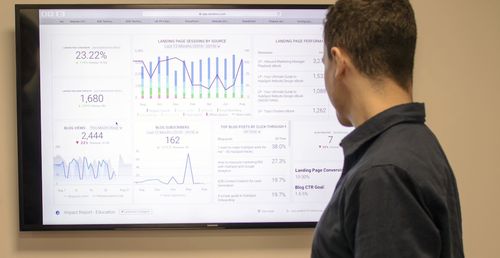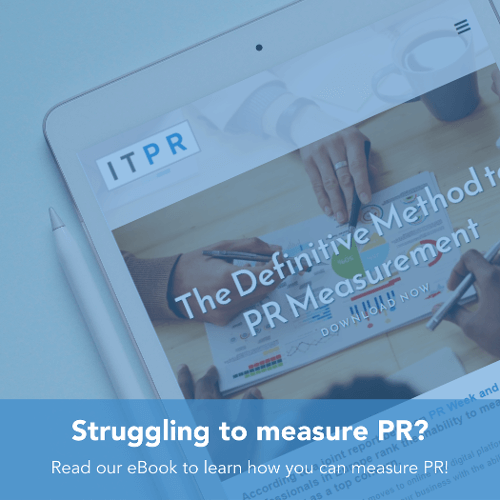One of the first things we ask prospects and clients when planning a new digital PR campaign is...
“What does success look like for you?”
It's an obvious question, but you’d be surprised at the variation of answers and in some cases how hard it can to answer at all.
Understanding and defining the goals of a digital PR campaign – or any PR or marketing campaign – is vital if you are going to determine its value in both the short and long term.
Part of the issue with failing to define what success looks like for a digital PR campaign is down to the industry being poor at providing accurate PR measurement and doing the hard work to prove the value it is having.
Getting media coverage and “raising brand awareness” are all clearly going to be measured as part of any campaign – if you’re failing to get media coverage from your PR then you’re failing.
With the increasing rise of digital PR and the use of data analytics, website measurement and keyword tracking tools available, PR measurement has to be more than just counting column inches or items of online media coverage.
Setting tangible PR goals
It's widely acknowledged that public relations as an industry was slow to adopt modern measurement techniques to determine tangible impact.
Yes, you managed to get loads of really great press coverage – but what has that done for your business?
Generating new links from media coverage to drive SEO improvement, increasing referral traffic by 15% from coverage or social media, or seeing a 67% improvement in website keyword performance are all indicators that you should be looking to measure your digital PR campaign against.
With tools like Google Analytics, Moz, SEMRush or CMS platforms like Hubspot, it is possible to measure the impact PR is having on your website.
All good and well, but where's the proof? Well take a trip to our case study page if you want to see how we've measured some of our previous campaigns.
What should you measure for PR success?
While there a huge number of metrics that you can use to measure the success of a digital PR campaign, there are a few essential things that should be top of the list when it comes to your PR measurement:
- Links generated from Earned media coverage – According to Google, legitimate links from high domain authority third party websites (like news websites) are a major contributing factor that will determine where your website places in search rankings. The challenge is, these links are the hardest thing to earn. Luckily, PR professionals should be best placed to get these links as they understand what kind of content journalists will write about, and link to, and also have the relationships with journalists to get the articles placed in the first place. When it comes to links, there are a few things to consider:
- Domain Authority (and relevance) of the website – News websites have among the highest domain authority of any site on the internet, save for educational websites, which is why getting links from these sites is like gold dust. But while domain authority is important, you still want to make sure the websites you’re targeting are relevant (and legitimate). After all, getting a link from a fashion website isn’t going to do you much good if you’re a seller of accounting SaaS products. Similarly getting loads of links from low domain authority “blog farms” or spammy websites isn’t going to do you much good. When it comes to links, think quality over quantity.
- Follow vs No-follow links – This has been a long running debate in the world of Digital PR and SEO for years. Does a link have any benefit if it’s a no follow link (as in it isn’t indexed by Google something to follow) This changed after Google decided to treat no-follow links as a “hint” for ranking purposes (meaning they’re not useless) but you should still be aiming for follow links.
- Domain Authority (and relevance) of the website – News websites have among the highest domain authority of any site on the internet, save for educational websites, which is why getting links from these sites is like gold dust. But while domain authority is important, you still want to make sure the websites you’re targeting are relevant (and legitimate). After all, getting a link from a fashion website isn’t going to do you much good if you’re a seller of accounting SaaS products. Similarly getting loads of links from low domain authority “blog farms” or spammy websites isn’t going to do you much good. When it comes to links, think quality over quantity.
- Increases in web traffic (both organic and referral) – buying is shifting online and the majority, no, all sales have some element of online interaction within the buyer journey. If you want to have any chance of succeeding today you have to be easy to find online, and provide your audience with useful, non-salesy – information when they get there. Referral traffic is an absolute must for PR measurement today. Getting coverage and links is hugely beneficial, but how has that impacted the number of visitors to your website, and what kind of visitors are they? Are they going to actually buy from you? By measuring the increase in traffic from referral traffic (news websites and social) you can evaluate the increase in numbers, but also use tools like Google Analytics to understand what they are doing when they get to your website. Are they doing the things you want them to (whether it’s downloading an eBook or booking a call with you?) Similarly, you should measure the impact of organic traffic on any PR activity you do. “Brand awareness” can be seen as a 'wishy washy' term to measure, but if your PR activity is bringing more people to your website then you must be doing something right.
- Keyword performance – If you don’t have a list of keywords that people will use to find you, or aren’t measuring their performance on the back of PR activity, then you should produce a list - now. While PR material is never going to be SEO optimised, by including non-branded descriptions of your company within articles and features you can help Google understand what your business does and help it to understand that you’re a website people should be going to – meaning you’ll rank higher in search.
- Website visitors to leads to customers – Is it really the job of a public relations campaign to win customers, or is that the job of marketing? This is a hotly debated issue and is largely driven by the increasing closeness with which PR and marketing work. They used to be two separate disciplines, but with Digital PR demonstrating the impact it can have on a company website, it is increasingly required that PR agencies generate not just more website visitors, but website visitors that will eventually turn into customers. While you’re PR agency cannot ultimately influence what a visitor does once they’ve got to your website (unless they’re also running content plans and inbound marketing campaigns for you) Digital PR should be measured on the quality of visitors being driven to your site. For example, which is better ... PR activity that brings in 1,500 new website visitors a month and 5 new customers, or one that brings 500 new website visitors a month and 25 new customers?
PR measurement has improved
The way PR is measured has fundamentally changed. Traditional PR has been left behind and Digital PR has taken over. If you’re continuing to measure PR success purely on media coverage and column inches then you're missing out.
Making the most of web analytics tools and getting more of an understanding of what they can tell you about a PR campaign will put you in a much better place to measure PR campaigns properly, and ensure you are getting the most out of your investment.
Considering that companies are spending more on Digital PR and social media now than in previous years, according to PRCA’s “Digital PR and Communications Report” the pressure is increasing for digital agencies to prove the value of this investment – and that can only be achieved through effective measurement.
Slightly worryingly, the report did highlight that outdated measurement techniques remained prevalent within some agencies, while others simply weren’t measuring their activity at all.
It is important that the PR industry looks ahead at how it can take measurement into the next decade and start to prove the real value of public relations – and digital PR – beyond the simple metric of counting coverage.
Still not sure how to set achievable goals for your PR campaign? Download our eBook which gives you more information of goals and other things you should consider when briefing a PR agency and setting up campaigns.
Tags: Digital PR, PR measurement





.png?width=60&name=twitter-logo%20(1).png)
